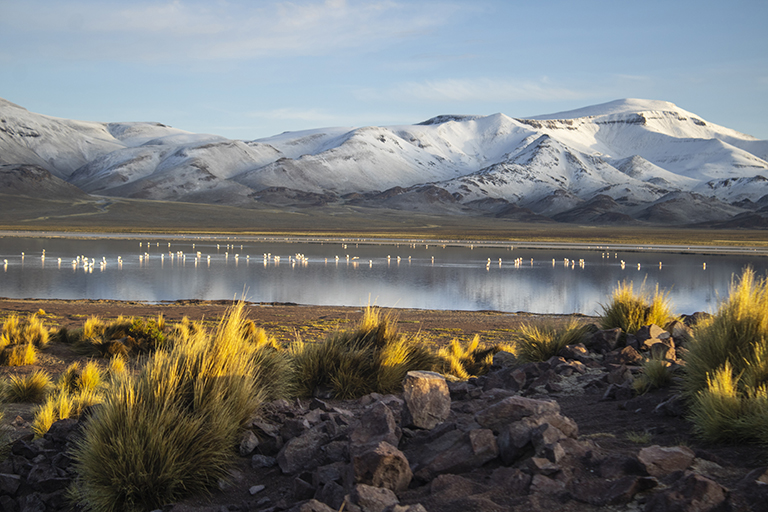Each summer, the rarest flamingos in the world congregate in the Andean highlands of Chile, Argentina, and Bolivia to feed in the region’s desert lakes. Amidst the vast expanses of salt flats, sparse vegetation, and austere snow-covered mountains, the bright pink Andean flamingo lends a surreal presence to an otherworldly landscape.
But even at 14,000 feet above sea level, the long-legged birds face threats from human encroachment and climate change. It’s estimated that there are fewer than 80,000 Andean flamingos, and a recent study conducted in Chile found that Andean flamingos are negatively impacted by lithium mining activities, which disturb the skittish birds and draw from scarce groundwater resources that drain nearby saltwater lakes.
To better understand Andean flamingos and how to protect them, Indiana University researcher Alex Jahn, a research scientist in the Department of Biology and former research fellow with the Environmental Resilience Institute, is tracking the birds to find out where they go and why.
“Flamingos are nomads. Nobody knows where a given Andean flamingo spends the year,” said Jahn. “Andean flamingos spend the brief Andean summer breeding in highland lakes, then mostly disappear until the following spring. They might go east one year and west the next, moving hundreds of miles between lakes. They need a shallow body of water to wade in and find zooplankton, their primary food source. What we’re trying to do is get a better understanding of how individual flamingos move, their migration routes, winter destinations, and habitat needs.”
To tag the birds, Jahn is collaborating with Enrique Derlindati, a professor at the National University of Salta, and with Joaquin Cereghetti, an experienced bird trapper. This past February, Jahn and his collaborators spent multiple days on the shores of Laguna Vilama, a large lake in northwestern Argentina that requires a two-day drive from the nearest city.
They capture flamingos using special “leg-hold traps,” which the flamingos walk into. Once caught, the researchers collect a feather sample to determine the sex of the bird using genetic analysis, weigh it, and place a GPS backpack on it before releasing it back to the wild. Satellites can track the birds for around two to four years, ample time to monitor where the birds go and how frequently they move between locations. Supplemented with environmental data, such as temperature, elevation, and weather, a clear picture of the Andean flamingo’s habits and preferences emerge.
The data is especially important for securing government protection for these birds. Due to a lack of information on their population size and the threats they face, Andean flamingos are not currently recognized as endangered by the International Union for Conservation of Nature.
“Right now, there’s no international agreement to protect Andean flamingos,” Derlindati said. “Though there are several protected reserves in the region, early data suggests flamingos spend most of the year in non-protected areas. International conservation laws are especially critical because flamingos regularly cross the borders of Chile, Argentina, and Bolivia.”
The impacts of climate change on Andean flamingos are another factor that researchers are attempting to investigate. When Jahn and his collaborators made the most recent trip to Argentina, Laguna Vilama was historically deep due to unusually high rainfall. The water depth made it more difficult for the flamingos to forage for zooplankton. Other lakes in the region have withered in size in recent years or dried up completely.
Ironically, much of the growth in lithium mining in the region is being driven by increased demand for a technology viewed as a solution to climate change—lithium batteries, which are installed in everything from cellphones, to laptops, to electric cars. The largest quantity of the planet’s accessible lithium lies in the central Andes, in the so-called “Lithium Triangle,” which spans much of the Andean flamingo’s range.
In a previous trip in 2020, Jahn tagged two Andean flamingos at one of their few known Argentinian breeding sites. To access the flamingos’ location, he had to get permission from the lithium mining company that was leasing the land.
“These are very remote sites where heavy equipment and many people are showing up to conduct large scale mining, virtually overnight,” Jahn said. “We need rechargeable batteries to address climate change, but we also need to be careful in how we transition away from fossil fuels.”
About the Environmental Resilience Institute
Indiana University’s Environmental Resilience Institute brings together a broad coalition of government, business, nonprofit, and community leaders to help Indiana and the Midwest better prepare for the challenges of environmental change. By integrating research, education, and community, ERI is working to create a more sustainable, equitable, and prosperous future. Learn more at eri.iu.edu.





